AUDI S3 2009 Owners Manual
Manufacturer: AUDI, Model Year: 2009, Model line: S3, Model: AUDI S3 2009Pages: 324, PDF Size: 76.02 MB
Page 291 of 324
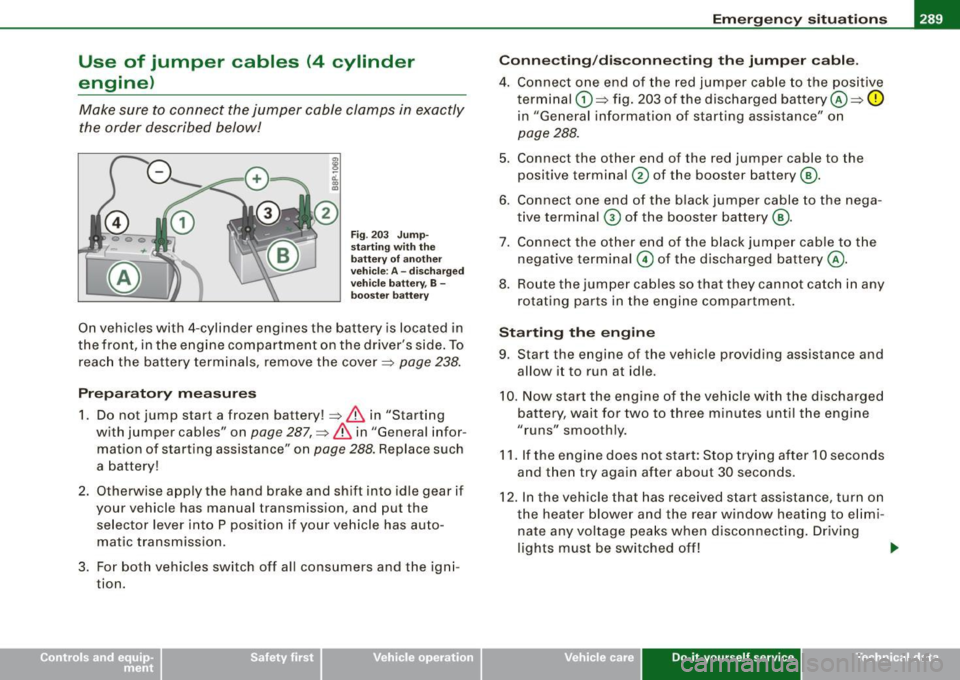
______________________________________________ E_ m_ e_r .;::g ;...e _ n_ c __,c. y_ s_it _u_ a_ ti_o _ n_ s _ __.ffllll
Use of jumper cables (4 cylinder
engine)
Make sure to connect the jumper cable clamps in exactly
the order described below!
Fig . 203 Jump
starting with the
battery of another
vehicle: A -discharged
vehicle battery, B -
booster battery
On vehicles with 4-cylinder engines the battery is located in
the front, in the engine compartment on the driver's side. To
reach the battery terminals, remove the cover=>
page 238.
Preparatory measures
1. Do not jump start a frozen battery!=> & in "Starting
with jumper cables" on
page 287, => & in "General infor
mat ion of starting assistance" on
page 288. Replace such
a battery!
2. Otherwise apply the hand brake and shift into idle gear if your vehicle has manual transmission, and put the selector lever into P position if your vehicle has automatic transmission.
3. For both vehicles switch off all consumers and the igni
tion.
Connecting/disconnecting the jumper cable.
4. Connect one end of the red jumper cable to the positive
terminal
G) => fig. 203 of the discharged battery©=> 0
in "General information of starting assistance" on
page 288.
5. Connect the other end of the red jumper cable to the
positive terminal
@ of the booster battery ®·
6. Connect one end of the black jumper cable to the nega tive terminal
G) of the booster battery ®·
7. Connect the other end of the black jumper cable to the negative terminal
© of the discharged battery@.
8. Route the jumper cables so that they cannot catch in any
rotating parts in the engine compartment.
Starting the engine
9. Start the engine of the vehicle providing assistance and
allow it to run at idle.
10. Now start the engine of the vehicle with the discharged
battery, wait for two to three minutes until the engine
"runs " smoothly.
11. If the engine does not start: Stop trying after 10 seconds
and then try again after about 30 seconds.
12. In the vehicle that has received start assistance, turn on
the heater blower and the rear window heating to elimi nate any voltage peaks when disconnecting. Driving
lights must be switched off! ._
Vehicle care Do-it-yourself service irechnical data
Page 292 of 324
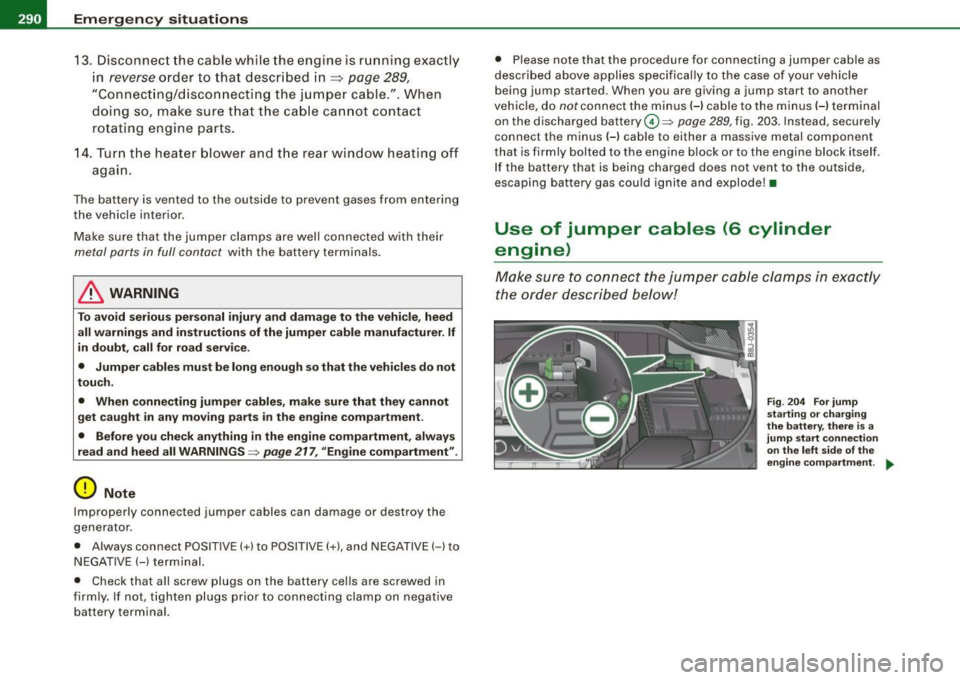
IIII.___E_ m_ e_r -=g "-e_ n _ c-=y _ s_ i_t _u _a _t_ i_o _n_ s _______________________________________________ _
13. Disconnect the c able while the engine is r unning exactly
in
reverse order to that described in~ page 289,
"Connecting/d isconnecting the jumper ca ble .". When
doing so, make sure t hat the cable cannot contact
rotating engine parts.
14 . Tur n the heater blower and t he rea r window heating off
again .
The battery is vented to the outside to prevent gases from entering
the vehicle interior.
Make sure that the jumper clamps are well connected with their
metal par ts in full contac t with the battery terminals.
& WARNING
To avoid seri ous pe rson al injur y and d am age to the vehi cle , heed
all warning s and in struct ion s of the jumper cable m anufa ctur er. If
in doubt , call for ro ad se rvic e.
• Jumper cable s mu st be l ong enough so that the vehicle s do not
t ou ch .
• When connecting jumper cable s, make sure that th ey cannot
g et ca ught in any mov ing p arts in the e ngine compa rt m ent .
• Bef ore you che ck anything in the engine com partment , al way s
r ea d and h eed all WARNINGS ~
page 217, "Engine compar tment".
0 Note
Improperly connected jumper cables can damage or destroy the
generator.
• Always conn ect POSITIVE ( +l to POSITIVE( +), and NEGATIVE( -) to
NEGAT IVE( -) terminal.
• Check that all screw plugs on the battery cel ls are screwed in
firm ly. If no t, tigh ten plugs prior to connecting clamp on negative
battery term inal. •
Please no te that the procedure for connecting a jumper cable as
described above applies specifical ly to the case of your vehicle
being jump started. When you are giving a jump start to another
veh ic le , do
not connect the minus(-) cab le to the minus( -) terminal
on the discharged battery ©~
page 289 , fig. 203 . Instead, securely
connect the minus( -) cab le to either a massive metal component
that is firmly bolted to the engine block or to the engine block itself .
I f the battery that is being charged does not vent to the outside,
escap ing battery gas cou ld ignite and explode !•
Use of jumper cables (6 cylinder
engine)
Make sure to connect the jumper cable clamps in exactly
the order described below!
Fi g. 2 04 For jump
starti ng or charging
th e batt ery, th ere is a
j ump start co nnect io n
o n th e le ft side o f the
en gine com partment. .,_
Page 293 of 324
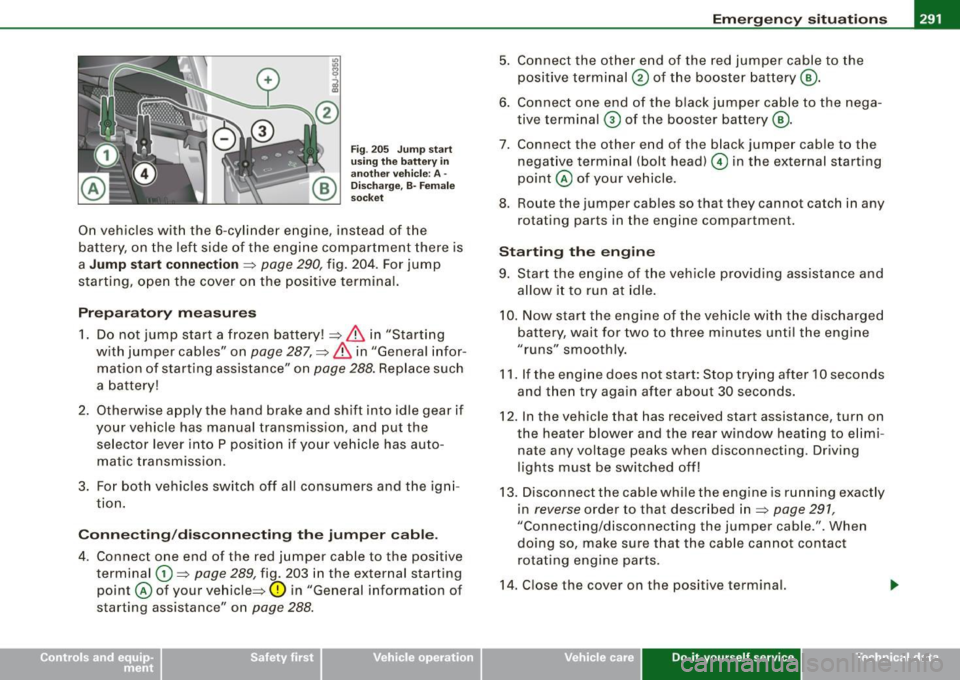
Emergency situations -____________________________ ___,::,:.___:_ ___ _
Fig. 205 Jump start
using the battery in
another vehicle: A -
Discharge, B- Female
socket
On vehicles with the 6-cylinder engine, instead of the
battery, on the left side of the engine compartment there is
a
Jump start connection => page 290, fig. 204. For jump
starting, open the cover on the positive terminal.
Preparatory measures
1. Do not jump start a frozen battery!=> & in "Starting
with jumper cables" on page
287, => & in "General infor
mation of starting assistance" on page
288. Replace such
a battery!
2. Otherwise apply the hand brake and shift into idle gear if
your vehicle has manual transmission, and put the selector lever into P position if your vehicle has auto
matic transmission.
3. For both vehicles switch off all consumers and the igni
tion.
Connecting/disconnecting the jumper cable.
4. Connect one end of the red jumper cable to the positive
terminal
G) => page 289, fig. 203 in the external starting
point @of your vehicle =>
0 in "General information of
starting assistance" on page
288.
5. Connect the other end of the red jumper cable to the
positive terminal
® of the booster battery @.
6. Connect one end of the black jumper cable to the nega tive terminal
0 of the booster battery @.
7. Connect the other end of the black jumper cable to the
negative terminal (bolt head)
© in the external starting
point @ of your vehicle.
8. Route the jumper cables so that they cannot catch in any
rotating parts in the engine compartment.
Starting the engine
9. Start the engine of the vehicle providing assistance and allow it to run at idle.
10. Now start the engine of the vehicle with the discharged battery, wait for two to three minutes until the engine
"runs" smoothly.
11. If the engine does not start: Stop trying after 10 seconds and then try again after about 30 seconds.
12. In the vehicle that has received start assistance, turn on the heater blower and the rear window heating to elimi
nate any voltage peaks when disconnecting. Driving
lights must be switched off!
13. Disconnect the cable while the engine is running exactly in reverse order to that described in=> page 291,
"Connecting/disconnecting the jumper cable .". When
doing so, make sure that the cable cannot contact
rotating engine parts.
14. Close the cover on the positive term inal. .,_
Vehicle care Do-it-yourself service irechnical data
Page 294 of 324
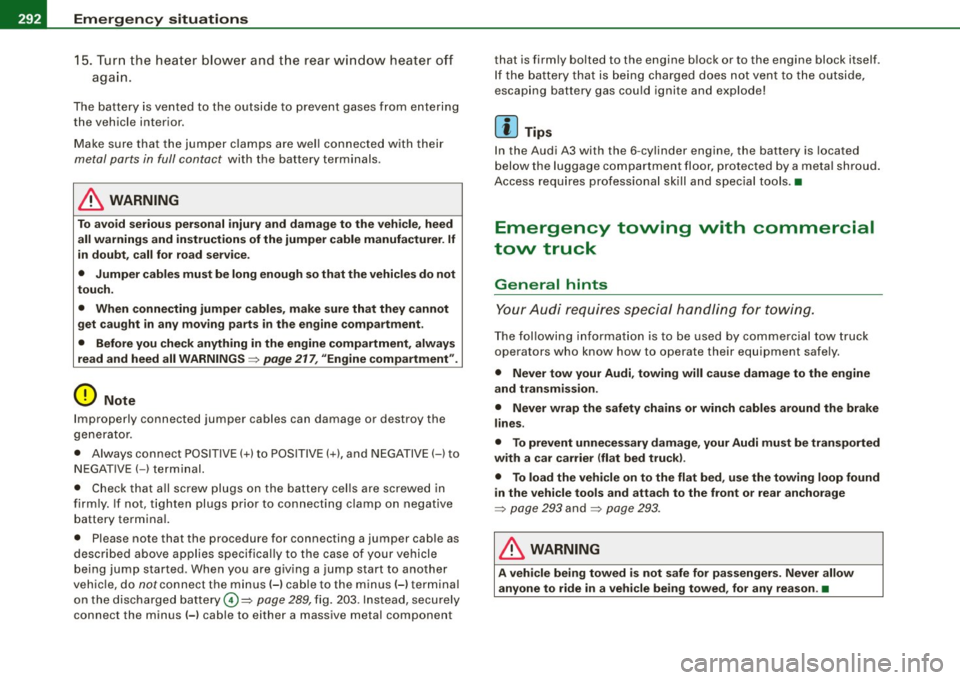
-L~E=m~e::,r~g~e~n~c::.y!'....:s~i:,.::t~u=.,::a:=.:t:!i.:::o:.:.n.:.:s~ ---------------------------------------------
15. Turn the hea ter blowe r and th e rear wind ow heat er off
aga in.
The battery is ve nted to the outs ide to preve nt gases from e nter ing
the veh icle interior.
M ake sure tha t th e jum per c lamps are well co nnected w ith their
metal parts in full contact with the battery terminals .
& WARNING
To avoid serious personal injury and damage to the vehicle , heed
all warnings and instructions of the jumper cable manufacturer. If
in doubt , call for road service .
• Jumper cables must be long enough so that the vehicles do not
tou ch .
• When connecting jumper cables , make sure that they cannot
get caught in any moving parts in the engine compa rtment .
• Before you check anything in the engine compartment , always
read and heed all WARNINGS=>
page 217, "Engine compartment ".
0 Note
Improperly connected jumper cab les can damage or destroy the
ge nerator.
• Always connec t POSI TIVE (+) to P OSITIV E(+), and NEGATIVE (-l to
N EGA TIVE( -) te rmi nal.
• Chec k th at a ll screw plugs o n the ba ttery cel ls are screwe d in
fi rm ly. If not, t ighten plu gs prio r to connect ing cla mp on neg ative
batte ry te rmina l.
• Please note that the procedure for connecting a jumper cab le as
de scribed abo ve applies specifical ly to the case of y our vehicle
being ju mp s tarted. W hen you ar e giving a jump start to anoth er
vehic le, do
not connect the mi nus( -) ca ble to the m inus( -) te rmina l
on the disc ha rged battery ©=>
page 28 9, fi g. 203. Ins tead, secu re ly
connect the minus( -) cable to either a massive metal component that is firm
ly bolted to the engine b lock or to the engine block itself.
I f t he b att ery t hat is bei ng c harge d does not vent t o th e ou ts id e,
escap ing battery gas cou ld ignite and explode !
[ i ] Tips
In the Aud i A3 with the 6 -cy linder engine, the battery is located
b el ow the luggage c ompartmen t fl oor, pro tec ted by a me ta l sh rou d.
Access requ ires pro fess io na l skill and special tools. •
Emergency towing with commercial
tow truck
General hints
You r Audi req uir es s pec ial ha ndl ing fo r t owin g.
T he fo llo wi ng infor matio n is to b e used by com merc ial tow t ru ck
operators who know how to operate the ir equ ipment safe ly.
• Never tow your Audi , towing will cause damage to the engine
and transmission .
• Never wrap the safety chains or winch cables around the brake
lines .
• To prevent unnecessary damage, your Audi must be transported
with a car carrier (flat bed truck) .
• To load the vehicle on to the flat bed , use the towing loop found
in the vehicle tools and attach to the front or rear anchorage
=> p ag e 293 and => page 293.
& WARNING
A vehicle being towed is not safe for passengers. Never allow
anyone to ride in a vehicle being towed , for any reason . •
Page 295 of 324
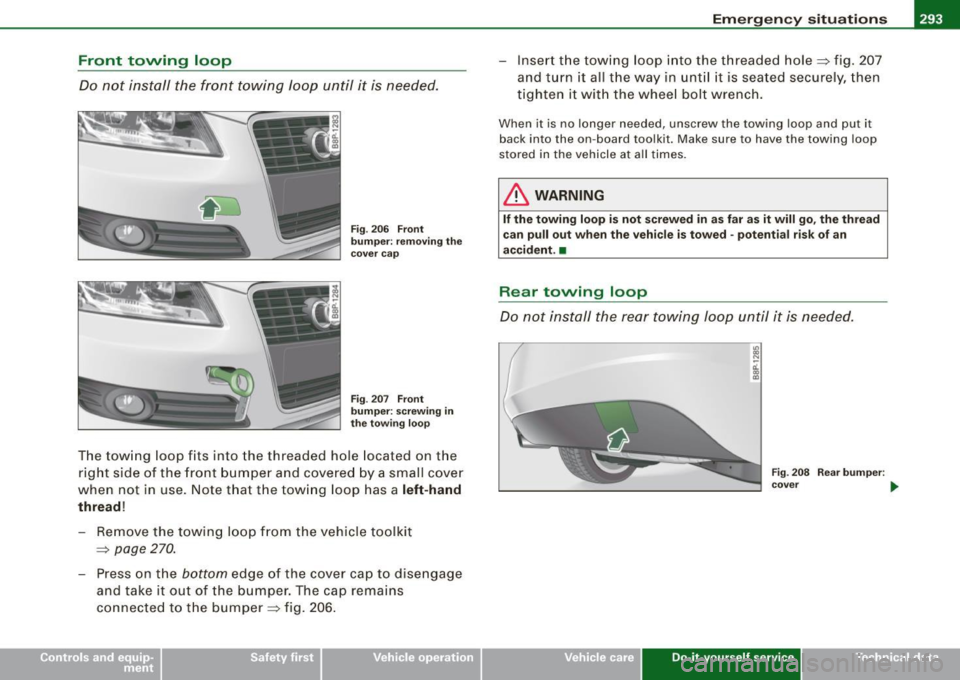
________________________________________________ E_ m_ e_r ,,::g c..e_ n _ c..::y;._ s_ i_t _u _a_ t_ i_o _n_ s _ ___.fflll
Front towing loop
Do not install the front towing loop until it is needed.
Fig. 206 Front
bumper: removing the
cover cap
Fig . 207 Front
bumper: screwing in
the towing loop
The towing loop fits into the threaded hole located on the
right side of the front bumper and covered by a small cover
when not in use. Note that the towing loop has a
left-hand
thread!
- Remove the towing loop from the vehicle toolkit
=>
page 270.
- Press on the bottom edge of the cover cap to disengage
and take it out of the bumper. The cap remains
connected to the bumper=> fig. 206. - Insert the
towing loop into the threaded hole => fig. 207
and turn it all the way in until it is seated securely, then
tighten it with the wheel bolt wrench.
When it is no longer needed, unscrew the towing loop and put it
back into the on-board toolkit. Make sure to have the towing loop
stored in the vehicle at all times.
& WARNING
If the towing loop is not screwed in as far as it will go, the thread
can pull out when the vehicle is towed -potential risk of an
accident. •
Rear towing loop
Do not install the rear towing loop until it is needed.
Vehicle care
~ N
-ci. co co
Fig. 208 Rear bumper :
cover ...
Do-it-yourself service irechnical data
Page 296 of 324
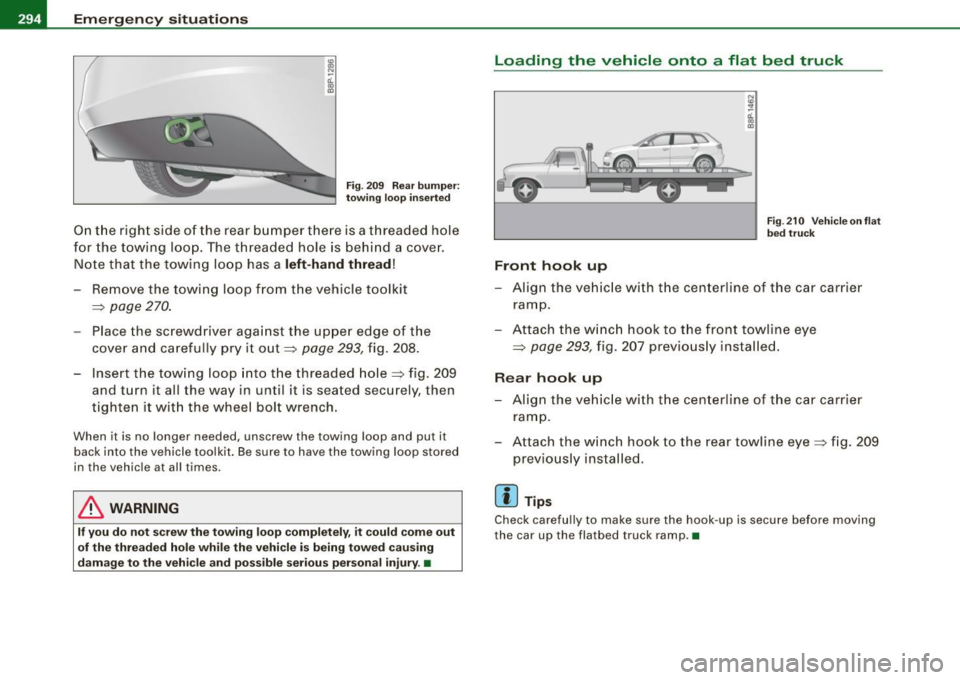
III...__E_ m_ e_ r -'g==-- e_n _ c_ y=--- s_ i_ t _u _a _ t_ i_o _n _ s _____________________________________________ _
Fig. 209 Rear bumper:
towing loop inserted
On the right side of the rear bumper there is a threaded hole
for the towing loop. The threaded hole is behind a cover.
Note that the towing loop has a left-hand thread!
Remove the towing loop from the vehicle toolkit
~ page 270.
Place the screwdriver against the upper edge of the
cover and carefully pry it out~
page 293, fig. 208.
- Insert the towing loop into the threaded hole~ fig. 209
and turn it all the way in until it is seated securely, then
tighten it with the wheel bolt wrench.
When it is no longer needed, unscrew the towing loop and put it
back into the vehicle toolkit. Be sure to have the towing loop stored in the vehicle at all times.
& WARNING
If you do not screw the towing loop completely, it could come out
of the threaded hole while the vehicle is being towed causing
damage to the vehicle and possible serious personal injury. •
Loading the vehicle onto a flat bed truck
Front
hook up
N
"' :? 0:. .,
"'
Fig. 210 Vehicle on flat
bed truck
-Align the vehicle with the centerline of the car carrier
ramp.
- Attach the winch hook to the front towline eye
~ page 293, fig. 207 previously installed.
Rear hook up
-Align the vehicle with the centerline of the car carrier
ramp.
- Attach the winch hook to the rear towline eye~ fig. 209
previously installed.
[ i] Tips
Check carefully to make sure the hook -up is secure before moving
the car up the flatbed truck ramp. •
Page 297 of 324
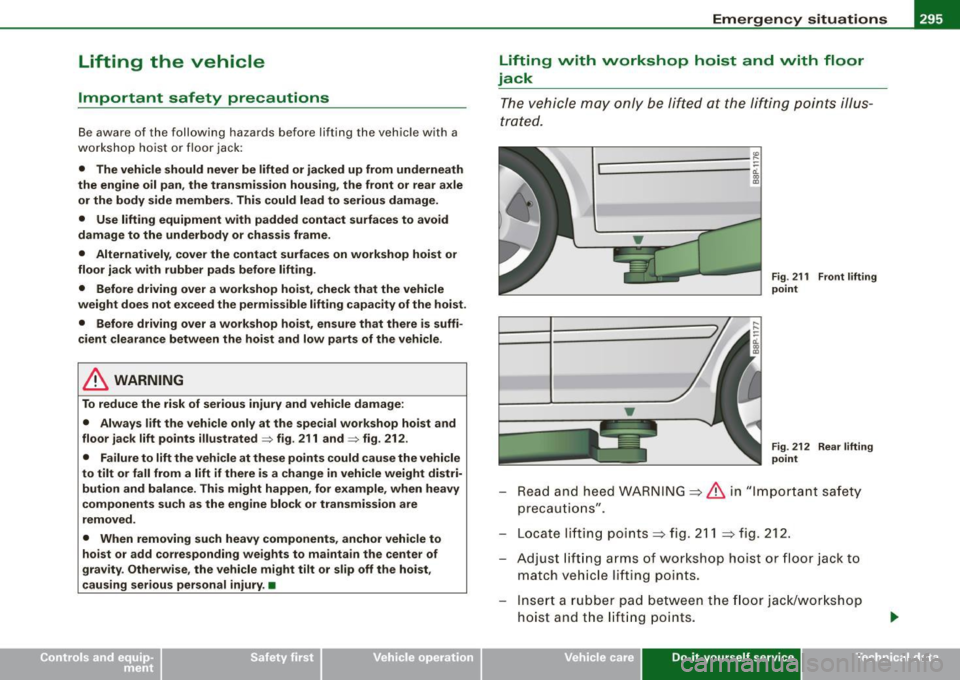
________________________________________________ E_ m_ e_r .::g :...e_ n _ c_,y'-- s_ i_t _u _a_ t_ i_o _n_ s _---JIIII
Lifting the vehicle
Important safety precautions
Be aware of the following hazards before lifting the vehicle with a
workshop hoist or floor jack:
• The vehicle should never be lifted or jacked up from underneath
the engine oil pan, the transmission housing, the front or rear axle
or the body side members. This could lead to serious damage.
• Use lifting equipment with padded contact surfaces to avoid
damage to the underbody or chassis frame.
• Alternatively, cover the contact surfaces on workshop hoist or
floor jack with rubber pads before lifting .
• Before driving over a workshop hoist, check that the vehicle
weight does not exceed the permissible lifting capacity of the hoist .
• Before driving over a workshop hoist, ensure that there is suffi
cient clearance between the hoist and low parts of the vehicle .
& WARNING
To reduce the risk of serious injury and vehicle damage:
• Always lift the vehicle only at the special workshop hoist and
floor jack lift points illustrated=> fig. 211 and=> fig. 212 .
• Failure to lift the vehicle at these points could cause the vehicle
to tilt or fall from a lift if there is a change in vehicle weight distri
bution and balance. This might happen, for example, when heavy
components such as the engine block or transmission are
removed .
• When removing such heavy components, anchor vehicle to
hoist or add corresponding weights to maintain the center of
gravity . Otherwise , the vehicle might tilt or slip off the hoist,
causing serious personal injury. •
Lifting with workshop hoist and with floor
jack
The vehicle may only be lifted at the lifting points illus
trated.
.... L===========::::==:: ~ 0:.
Fig . 211 Front lifting
point
Fig . 212 Rear lifting
point
Read and heed WARNING~ & in "Important safety
precautions ".
Locate lifting points~ fig. 211
~ fig. 212.
Adjust lift ing arms of workshop hoist or floor jack to
match vehicle lifting points.
Inse rt a rubber pad between the floor jack/workshop
hoist and the lifting points.
Vehicle care Do-it-yourself service irechnical data
Page 298 of 324
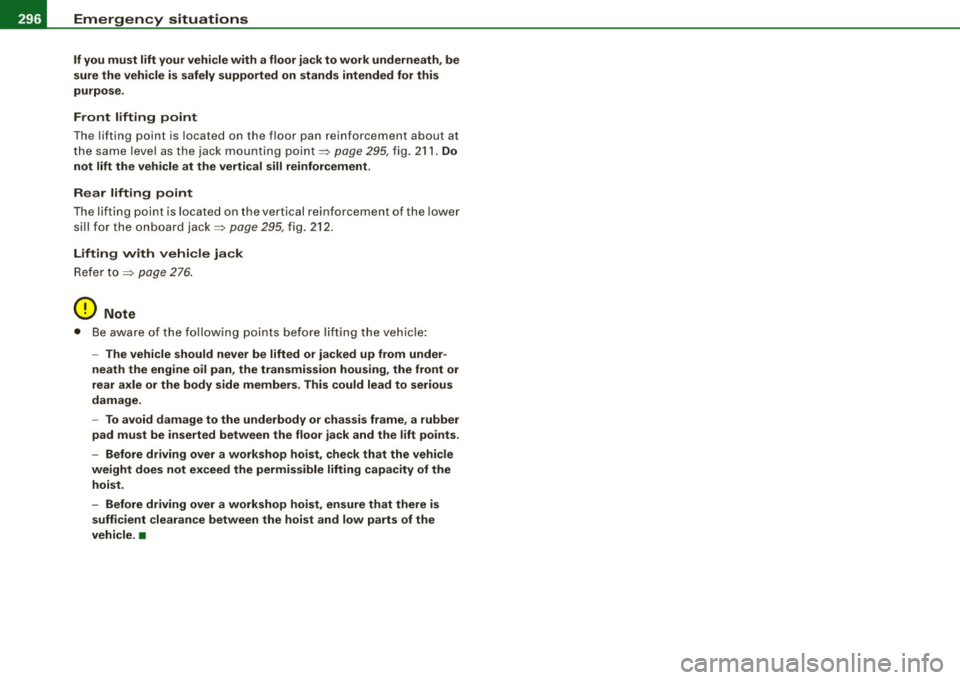
11111.___E_ m _ e _r-==g :...e_ n_ c...:y _ s_ i_t _u _a _t_ i_o _n_ s _______________________________________________ _
If you mu st lift your veh icle with a floor jack to work underneath , be
sure the vehicle is safely supported on stands intended for this
purpose .
Front lifting point
T he lifting point is located on the floor pan reinforcement about at
t he same leve l as t he jac k mou nti ng poi nt=>
pag e 295, fig. 2 11. Do
not lift the vehicle at the vertical sill reinforcement .
Rear lifting point
T he lifting point is located on the vertical reinforcement of the lower
sill for the o n board jack=>
page 295, fi g. 212 .
Lifting with vehicle jack
Refe r to=> page 276.
0 Note
• Be aware of the fo llo wi ng po ints before l ifting t he ve hicle :
- The vehicle should never be lifted or jacked up from under
neath the engine oil pan , the transmission housing , the front or
rear axle or the body side members . This could lead to serious
damage.
- To avoid damage to the underbody or chassis frame , a rubber
pad must be inserted between the floor jack and the lift points .
- Before driving over a workshop hoist, check that the vehi cle
weight does not exceed the permissible lifting capacity of the
hoist .
- Before driving over a workshop hoist , ensure that there is
sufficient clearance between the hoist and low parts of the
vehicle. •
Page 299 of 324
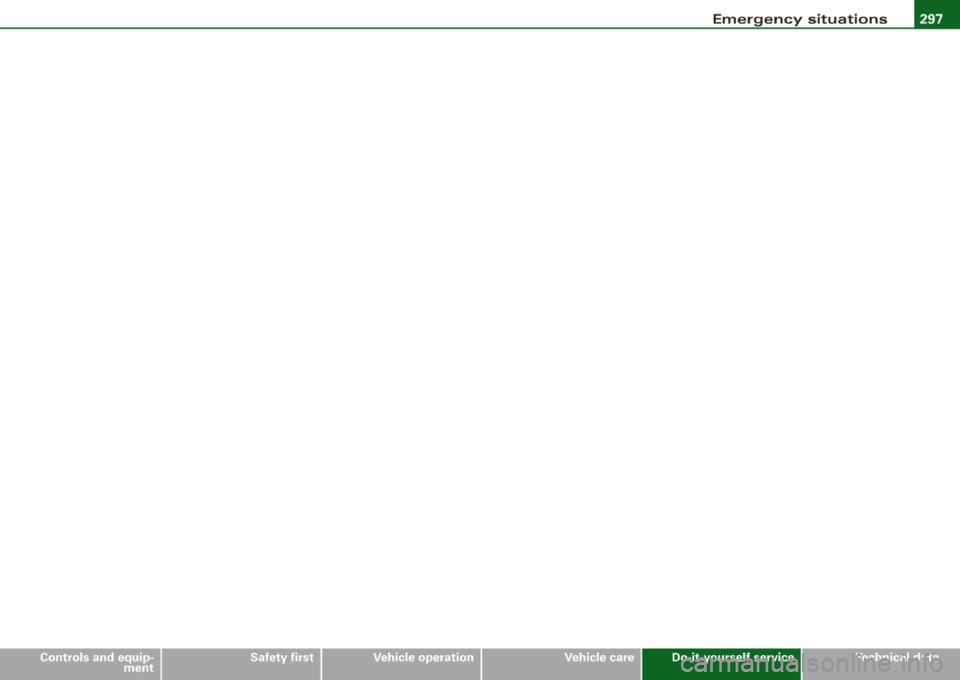
________________________________________________ E _m_ e_r.:g :;,. e_ n_c ...: y:.- s_ i_ t _u _a_ t_ i_ o _ n_ s __ ffllll
• Do-it -yourself service
Page 300 of 324
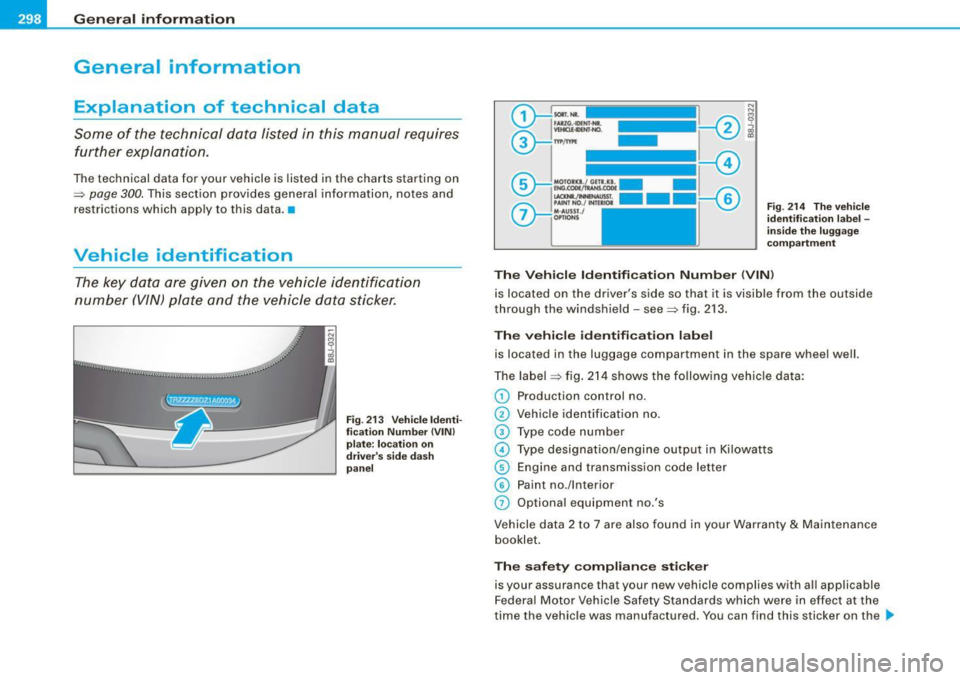
___ G_ e_ n_ e_r_ a _ l_ in_ f_ o _r_m _ a_ t_ i_ o _ n __________________________________________________ _
General information
Explanation of technical data
Some of the technical data listed in this manual requires
further explanation.
The technical data for your vehicle is listed in the charts starting on
~ page 300. This section provides general information, notes and
restrictions which apply to this data. •
Vehicle identification
The key data are given on the vehicle identification
number (VIN) plate and the vehicle data sticker.
Fig. 213 Vehicle Identi
fication Number (VIN)
plate: location on
driver's side dash
panel Fig
. 214 The vehicle
identification label -
inside the luggage
compartment
The Vehicle Identification Number (VIN)
is located on the driver's side so that it is visible from the outside
through the windshield -see ~ fig. 213.
The vehicle identification label
is located in the luggage compartment in the spare wheel well.
The label ~ fig. 214 shows the following vehicle data:
© Production control no.
0 Vehicle identification no.
© Type code number
© Type designation/engine output in Kilowatts
© Engine and transmission code letter
© Paint no./lnterior
0 Optional equipment no.'s
Vehicle data 2 to 7 are also found in your Warranty
& Maintenance
booklet .
The safety compliance sticker
is your assurance that your new vehicle complies with all applicable
Federal Motor Vehicle Safety Standards which were in effect at the
time the vehicle was manufactured. You can find this sticker on the ._